|
PHYSETER
CATODON
Length:
12–18 meters.
Weight: 30–50 tons.
Worldwide population: Uncertain, at least few hundred thousand.
Life expectancy: Ca. 70 years.

The
Sperm Whale
Fully
grow adult males are 17-20 m long and weigh 40-52 tons.
Females are 8-17 m long and weigh 20-38 tons.
Life expectancy is 60-80 years.
The body is dark grey on top, the sides are lighter in
colour, and the underside is silver grey.
The eyes and the flippers are relatively small and the
dorsal fin is almost non-existent. Most of the 30 teeth are
situated in the narrow, lower jaw, each about 20 cm long.
The brain is the largest of any extant animal and weighs
about 10 kg.
Specialists estimate the sperm whale’s greatest diving depth
to be 3200 m, and more than two hours if necessary.
Its usual dives take about 15 minutes.
The head is more than a third of the whale’s length and
contains great quantities of very fat oil, which may enable the
whale to dive so deep. This
oil probably is distributed through the body according to its
positions and depth, and contains added oxygen and equalizes the
pressure.
Octopus
is its main food, but it also eats squid and a few species of
fish, such as tuna, giant skate, and
shark.
In Icelandic waters, it also feeds on ocean perch,
lumpfish, monkfish, cod, saithe, and spotted catfish.
Sperm whales usually bear marks on their heads of the
constant fights with the octopus.
Sperm whale males
behave very differently to other species of whales in their
mating. They
collect a harem of 20-30 cows and watch it very carefully.
They usually mate in April during the migration to the
north. The
gestation period is about 16 months, and the calf’s size at
birth is about 4 m and one ton.
It is suckled for about a year and pregnancies occur
every third year. Females
reach their puberty at the age of 7-13 and the males at 17-21.
Sperm Whales are found in all oceans of the world, but it
prefers warm seas. Only
old or young males migrate to Icelandic waters during summer in
groups of 10-20. Their
total number is estimated to be 1400.
The total world population is estimated 1½ - 2 millions.
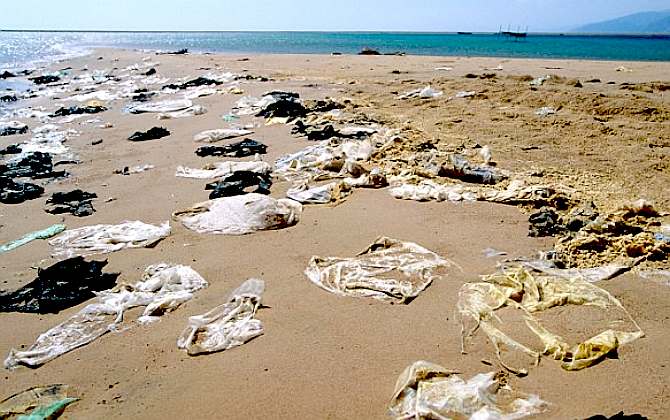
JULY
29 2013 - OCEAN PLASTIC WASTE
A
sperm whale was stranded on Tershelling, a northern island in the
Netherlands. A rescue attempt was attempted, but unfortunately the whale died. A young adult at 13.5 meters was taken for a necropsy at the port of Harlington. The sperm whale had plastic in its stomach, an increasing common phenomenon say researchers at the Biodiversity Centre Naturalis.
In March
2013, a 10 meter long sperm whale washed up on Spain’s South Coast. This whale had swallowed 59 different plastic items totaling over 37 pounds. Most of this plastic consisted of transparent sheeting used to build greenhouses in Almeria and Grenada
to grow tomatoes for the European market. The rest was plastic bags, nine meters of
rope, two stretches of hosepipe, two small flower pots, and a plastic spray canister.
The cause of death was intestinal blockage.
These are not uncommon incidents. In 1989, a stranded sperm whale in the Lavezzi Islands in the Tyrrhenian Sea died of a stomach obstruction after accidentally ingesting plastic bags and 100 feet of plastic sheeting. In 1990, a sperm whale examined for pathology in
Iceland died of an obstruction of the gut with plastic marine debris. In August of 2008, a sperm whale washed up in Point Reyes,
California with 450 pounds of fishing net, rope, and plastic bags in its stomach. The California Marine Mammal Stranding Database tells of another sperm whale stranded in 2008 with stomach contents that included an extensive amount of netting from discarded
fishing gear.
The sperm whale that stranded in the Netherlands had a large part of its lower jaw missing. Among hundreds of thousands of sperm whales that
whalers harpoon, regularly encountered are sperm whales with broken or deformed lower jaws. Most of these whales have full stomachs and are healthy right before being slaughtered. This, and the fact squids are found in their stomachs whole and seldom show bite marks, lead to a theory that the lower jaw plays no significant role in catching of prey and that these sperm whales instead suck their food in. If this theory
proves to be correct, then sperm whales are just as vulnerable as baleen whales to the ingestion of marine
debris, the fastest cure for which could be the SeaVax
ocean going vacuum cleaners (Cleaner
Oceans Club). If that is, we act fast enough to kickstart
such a programme, and also support other projects that stand a
chance of contributing to cleaning up the oceans, another of
which is Boyan
Slat's Ocean Cleanup Project.
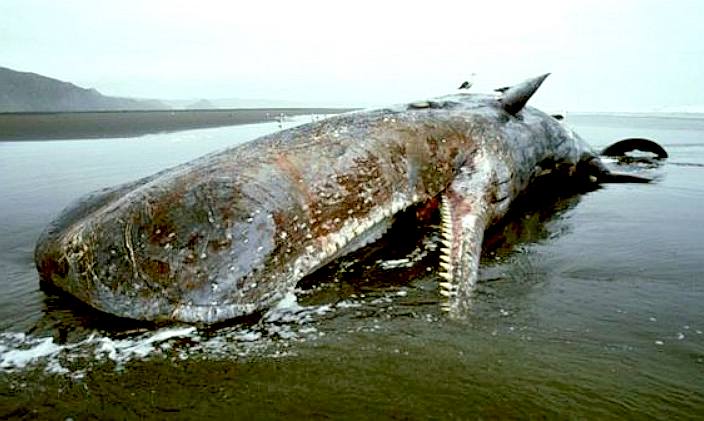
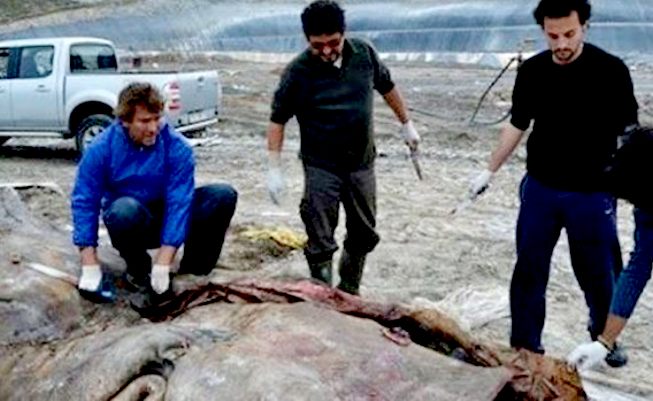
“About 100 plastic debris and bags killed a young sperm whale found stranded in Mykonos Island in Greece in 2006. Together with pieces of nets, ropes and plastic covers of all kind of human products, they were found in the stomach of the sperm whale by the scientific team of the
Pelagos Cetacean Research
Institute.
BEAKED WHALES
Another family of deep diving, squid eating cetaceans is the beaked whales. May 2011, a female juvenile Gervais’ beaked whale was found on a beach in
Puerto Rico with ten pounds of plastic in her stomach. In July 2006, a 20-year old female Cuvier’s beaked whale died in the Cook Islands, Rarotonga after ingesting a single plastic bag. Sperm whales and beaked whales are especially susceptible to swallowing plastic and
fishing gear as they resemble their natural prey, squid, the same way a sea
turtle is susceptible to swallowing plastic bags because they resemble jelly fish.
NATIONAL
GEOGRAPHIC, JAN 2015
In August of 2014, biologists from the Virginia Aquarium and Marine Science Center Stranding Response Team were notified of an unusual sighting in the Elizabeth River, a busy, industrial tributary of the Chesapeake Bay. A 45-foot-long young female
sei whale was spotted swimming up the river, far from the deep waters of the Atlantic where the species, listed as endangered, is normally found.
"She was in the wrong place at the wrong time," says the aquarium's research coordinator Susan Barco.
The whale seemed disoriented. Barco and her colleagues followed it for several days in an attempt to protect it from a fatal collision with a ship. Despite these efforts, the whale was found dead a few days later.
A necropsy revealed the animal had swallowed a shard of rigid, black plastic that lacerated its stomach, preventing it from feeding. The weakened whale also had been struck by a
ship and suffered a fractured vertebrae. "It was a very long and painful decline," Barco says.

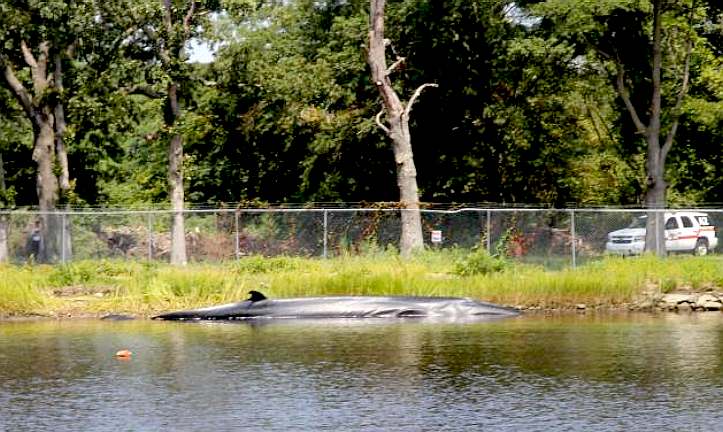
The shard that caused the whale's demise was identified as a broken piece of
DVD case. Most likely the marine mammal had swallowed the debris while feeding at the surface.
"It makes me very sad that a piece of plastic that was not disposed of properly ended up killing a whale," she says. "It was a preventable death."
Plastic ingestion is a widespread problem for marine animals, particularly seabirds and turtles, which can easily confuse the debris for food. The indigestible material can obstruct the stomach or intestine, leading to starvation and death. As the amount of sea trash increases, so do the risks to marine life.
To compound the problem, scientists are still trying to fill in the blanks when it comes to the impact of marine debris on cetaceans. A 2014 study found that ingestion of debris has been documented in 56 percent of cetacean species, with rates of ingestion as high as 31 percent in some populations.
"The whales that wash up on the beach are only a small percentage of those that die," says Frances Gulland, a senior scientist with the Marine Mammal Center in Sausalito, California.
Sperm whales are particularly susceptible to plastic debris ingestion, she explains; they mistake debris for squid, their main prey. "Every sperm whale that I have necropsied has had a lot of nets and pieces of plastic" in its stomach, she says.
Gulland encountered her most extreme case in 2008 - two male sperm whales stranded along the northern California coast, their stomachs full of pieces of fishing net, rope, and other plastic trash. One animal had a ruptured stomach. The other was emaciated, suggesting that it had been unable to eat. In both cases, the debris proved fatal.
The variety and age of some of the plastic suggested it had accumulated over many years. According to Gulland, who performed the necropsy, one of the whales had at least 400 pounds of debris in its stomach.
"They slowly died of starvation," she says. "It was the first time that I had seen a large whale die from eating garbage debris."
NOAA Fisheries Southeast marine mammal stranding coordinator Blair Mase says the number of whales and dolphins impacted by floating marine debris seems to be on the rise. Though the statistical accounting can be tricky, Mase counts at least 35 strandings of bottlenose dolphins in her region between 2002 and 2013 due to marine debris.
But surface debris is not the only culprit. Gray whales feed on the ocean bottom and inadvertently suction up marine debris along with small organisms like amphipods. In 2010, John Calambokidis, a research biologist with Cascadia Research in Olympia,
Washington, assisted in the examination of a dead gray whale that had stranded near Seattle.
The debris found in the 37-foot male included more than 20 plastic bags, small towels, surgical gloves, a pair of sweatpants, duct tape, and a golf ball.
"It was," Calambokidis says, "a dramatic representation of the degree to which we impact the marine environment."
DAILY
EXPRESS, MARCH 11 2013
The death of a sperm whale that washed up on Spain's south coast has been linked to British
supermarkets after it was found to have swallowed 37 pounds (17kg) of plastic waste dumped into the sea.
The waste had reportedly been dumped by farmers who tend greenhouses that provide produce for
British supermarkets.
Shocked scientists found the incredible amount of garbage, totaling nearly three stone, blocking the whale's stomach – including some 30 square metres (36 square yards) of plastic canvas.
"We quickly realised that it had a real greenhouse inside its stomach," Renaud de Stephanis, a marine biologist at the Donana Biological Station said.
"We did not expect it, but it did not surprise us," he added.
The plastic blocked the 4.5 tonne animal's stomach and killed it, according to the researchers from the Doñana national park research centre in Andalusia.
“It was as if it had a rock inside its intestine, nothing could get through. There was so much plastic that it finally exploded,” de Stephanis said.
They found the plastic protruding through a tear in the whale's stomach, which contained two dozen pieces of transparent plastic, some plastic bags, nine metres of rope, two stretches of hosepipe, two small flower pots and a plastic spray canister.
The plastic was reportedly typical of the closely packed Almeria greenhouses that cover about 40,000 hectares.
The greenhouses produce 2.4 tonnes of plastic waste per hectare each year – or more than 45,000 tonnes altogether.
Tesco,
Waitrose and
Sainsbury's are all valued customers at the greenhouses where the plastic is said to originate, local farmers have reported.
Over 250 marine animals including turtles, dolphins and
otters, have problems because of plastic garbage that finds its way into the ocean and which can cause them to choke, de Stephanis said.
The discovery is worrying because it shows that "the sea is full of rubbish" and that waste management systems for plastic, not only in
Spain, are not always effective, he said.
"These big plastics crumble and the little pieces also go inside
fish. And that is what we end up eating," said de Stephanis.
By Charlotte Meredith
DAILY
MAIL, FEBRUARY 8 2012 - How plastic bags are poisoning the planet's greatest predators: 65ft long sperm whales are being killed by human pollution.
You quickly run out of superlatives when talking about whales.
They are the largest, loudest and longest-lived animals on our planet. How amazing, then, that we should still know so little about them — and that our ignorance has led these beautiful creatures into clear and present danger.
As a writer, I’ve studied whales around the world — from majestic blue whales off Sri Lanka to the playful
humpbacks of Cape Cod. But it is the enigmatic sperm whale which fascinates me.
It has the biggest brain of any animal — a massive 18lb to our human 3lb — yet we really have no idea what it does with it.
This magnificent predator — at 65ft long, the greatest that has ever existed — spends 90 per cent of its life in the profound depths, able to dive deeper than any other animal.
For precisely that reason, it is the least studied of all the great whales.
And of all whales, it is under the greatest threat, too — from what we humans are doing to its environment. Only now are we beginning to understand these creatures. But is it too late?
This week the results of the first Whale Symposium ever held in Britain were published in a book I co-edited.
It contains new scientific research revealing the true nature of this most mysterious ocean giant, but also the devastating impact we humans are having on them — not least because we pollute their habitat with plastic bags and other waste — and the terrible problems they face as a result.
The sperm whale is a natural submarine, a miracle of evolutionary engineering. It is actually able to change the physical shape of its body to accomplish its
dives.
At the surface, it will breathe deeply, like an athlete getting ready for an event. It exchanges all the carbon dioxide in its body for oxygen, storing it in its muscles.
Humans do this to a certain extent, but the whales’ muscles are far more efficient at the process, as demonstrated by their almost black colour, an indication of how supercharged they are with myoglobin, which binds the oxygen to their blood.
As it prepares to dive, the sperm whale undergoes one of nature’s most amazing transformations. Its characteristically square head is in fact an extended nose. Fifteen feet long from nostril to shoulder, it contains a massive reservoir of spermaceti oil.
This waxy oil has remarkable bio-acoustical properties. It is used to amplify the sonar clicks that echo along the animal’s head and out into the ocean.
The result is the loudest noise created by any animal — 230 decibels, as loud as a jet engine and powerful enough to be heard six miles away.
As the whale dives, its massive nose, which is plump and bulbous when at the surface, is squeezed into a narrow,
hydrodynamic wedge shape — the better to allow the animal’s plunge into the abyss.
The whale then shuts down every organ in its body, except heart and brain, in order to conserve energy and oxygen.
Its lungs collapse as the animal’s ribs close in on bony hinges, lubricated by special mucus. If they did not, the increased pressure below would snap its ribcage.
Any air left in its body is confined to its nasal passages, where it is needed to generate the sonar clicks the animal uses to hunt.
Its flippers fit into its sides like an aircraft’s undercarriage. Everything is
streamlined.
Finally, the whale uses the rippling muscles in its tail to jack-knife downwards with an astonishing power.
Having witnessed this feat from water-level, I can attest to its amazing dexterity. The animal is so beautifully designed that it barely leaves a ripple at the surface. Amazingly, when it reappears, it will do so at almost exactly the same point.
A sperm whale can dive down for more than a mile, to depths which would crush a human being’s internal organs at a pressure of 500lb per square inch.
In just five minutes, it can reach a depth of 500 metres, the limit at which a human diver can work.
Soon it will far exceed that, reaching 1,000m — its favoured hunting ground. We do not know exactly how the whale’s body resists such pressure. But it must be comfortable down there, since it can spend two hours underwater.
In the inky darkness, the whale hunts by using its sonar as a sweeping scan, in search of its favourite food: squid.
Their prey ranges from shoals of creatures little bigger than cuttlefish to gargantuan giant squid up to 50ft long.
As they zone in on them, the whales appear to communicate in strange growls and buzzes. Are they indicating the direction and source of their food? Maybe they’re just happy at eating.
Each sperm whale must consume up to 1,000 squid a day — that’s 1,100lb or half a ton of calamari! Although it has a 10ft-long jaw studded with 42 of the biggest teeth in the animal kingdom (each up to 2ft long), it does not bite its prey.
Instead, it sucks up its food like a giant vacuum cleaner, swallowing the squid whole. We know this from the stomach contents of dissected whales.
Or, as I have seen myself in the Azores, from the loose tentacles that break off in the process and float to the surface. Unlike the whale, which decompresses as it resurfaces, a squid’s body cannot survive the rapid change in pressure. It liquifies to a gooey, soupy mess.
Occasionally, however, a sperm whale will feed at the surface. Off Kaikoura in
New Zealand, where the waters run six miles deep, I watched a massive, 50ft male sperm whale at the surface.
Around it were circular patches of disturbed water — the result of the ultra-loud sonar bursts it was using to knock out yard-long kingfish — almost like a sonic gun. It is a lethal weapon unique to sperm whales, so intense that they can kill prey at a distance.
I watched as the whales’s great head erupted from the waves, a stunned fish in its huge toothed jaws. It looked as if it were triumphantly claiming its prize. But no one has ever witnessed a sperm whale feeding at depth — although that may be about to change.
Professor Hal Whitehead is one of the world’s most pre-eminent experts on this amazing species. He told me recently that new equipment currently being developed will allow scientists to attach cameras to whales and record their foraging behaviour.
Already, using high resolution digital electronic tags which monitor exact movements, speed and ocean depths, Hal and his colleagues have been able to trace much of what sperm whales get up to in the deep.
But it may be some time before we can see for ourselves the greatest battle known to nature — the mythical struggle between the sperm whale and the giant squid.
It has even been claimed that the squid will use its tentacles to smother the whale’s blow hole in an ultimately futile attempt to defeat its foe.
For centuries man has hunted the sperm whale, principally for that precious oil in its pugnacious head. Before the discovery of mineral oil, sperm whale oil burned in street lights and oil lamps. It lubricated the machines of the Industrial Revolution.
It was even used in the NASA space missions as lubrication for space probes, since it does not freeze in sub-zero temperatures.
In 200 years we managed to reduce their population from two million to 360,000.
Luckily, most of the world no longer hunts these beautiful creatures. But now, tragically, there are new dangers to their wellbeing.
By virtue of its position at the top of the marine food chain, the pollution we dump in the sea affects sperm whales more than any other creature.
One of the greatest problems faced by any marine species is the sheer amount of plastic in the ocean, especially plastic bags, as has been highlighted by the Daily Mail’s campaign against the profligate use of them.
Dr Ruth Leeney notes in the book I co-edited, Dominion: A Whale Symposium, these bags don’t biodegrade. They break down into smaller fragments that enter the food chain — and eventually the whales’ bodies.
‘It is ironic that a plastic shopping bag, with so short a lifespan in a person’s existence, can have a powerfully negative impact elsewhere, by causing unnecessary death’, says Dr Leeney.
As my fellow editor, artist Angela Cockayne notes, a minke whale recently stranded itself on the French coast. Its stomach was clogged with 800kg of plastic, including British supermarket bags.
One problem for the sperm whale is, ironically, its awesome success. It inhabits every ocean and almost every sea, from the vast Pacific to the enclosed Mediterranean. This is because it has evolved to find the perfect feeding niche, albeit a mile below the surface of the ocean.
It is a staggering fact that sperm whales eat more squid and fish each year — 100 million tons, than the 70 million tons we
humans catch and consume per annum.
The sperm whale has to eat so much to fuel its huge brain, which is highly expensive, in calorific terms, to run.
Given the size of their brains, sperm whale society is remarkably complex. Like the African elephant, it is matriarchal. So much so that females which are unrelated genetically will ‘baby-sit’ each other’s calves when they dive to feed.
The whales also travel almost inconceivable distances. Every year, male sperm whales migrate towards the poles, returning toward the equator to breed. One male may travel more than 1,000km a month.
They communicate in a complex system of Morse-code-like clicks, and each ‘clan’ has a different dialect, in the way a Yorkshire accent differs from a Devon one.
Individual animals may be miles apart but they are always in intimate contact, through their extraordinary sense of hearing.
Such supreme adaptability means that sperm whales live to great ages, at least 100 years old. Bowhead whales, their cousins, live to even greater ages — up to 300 years and perhaps even older, making them the planet’s longest living mammal.
We know this from ancient harpoons that have been found embedded in the blubber of bowheads, and which have been Carbon-14 dated to 235 years and older.
It means whales may be swimming in the sea now which were alive before Victoria ascended the throne or
Captain Cook discovered Australia.
By living so long, whales are of course susceptible to diseases of old age, like humans. But they are also subject to the effect our modern habits are having on their world.
On a recent trip to the U.S. University of Southern Maine in Portland, Dr John Wise showed me new research he has been conducting into the way contaminants from the chemical industry are entering the sperm whales’ bodies.
He explained how chromium, a deadly carcinogen which induces lung
cancer in humans, is released from chemical processing plants into the air.
The whales, which pass by such plants on the coast of Queensland, northern
Australia on their migratory routes, absorb the chromium because they breathe so deeply at the surface.
The result is causing changes to immune systems, and fertility, creating birth defects analogous to Down’s syndrome in humans.
In another recent and tragic case, a group of seven sperm whales stranded themselves on a Mediterranean beach. They had been driven into shallow waters, possibly by military sonar exercises. There they were unable to feed on squid. And since whales get their liquid from their food, they began to dehydrate.
Then, their starving bodies began to break down fat — to deadly effect. The pollutants they’d absorbed from the ocean and had been deposited in their fat were released.
They included heavy metals such as mercury, lead and cadmium, and organochlorines like
PCBs* and DDTs**, even fire-retardants used on modern furnishings.
In effect, the whales were poisoning themselves. Fatally weakened, they stranded themselves together on the shore, demonstrating the unswerving loyalty to each other for which their species is renowned.
And when their carcases were dissected, it came as no surprise to discover an unusual amount of plastic, including the dreaded plastic bags, in their stomachs.
What a tragic end for such magnificent animals. And what a salutary lesson for us humans.
By Philip Hoare
*
Humans are exposed to PCBs via food,
air and drinking water. Humans are mainly exposed through consumption of contaminated foods, particularly meat, fish, and poultry. The dietary intake of PCBs for adults rose to a high in the late 1970s, but then decreased to a lower level by the 1990s. Ocean plastic waste may cause the levels to rise again.
**
We are exposed to DDT by eating contaminated fish and shellfish, through breast milk, by eating imported food exposed to DDT, and by eating crops grown in contaminated soil.
The harmful effects of DDT are: that it is a probable human carcinogen, that damages the liver and can cause liver cancer, the nervous system, reduces reproductive success by damaging the reproductive system.
LINKS
Daily
Mail news
Sperm-whales-How-plastic-bags-poisoning-planets-greatest-predators
Express
UK News Whale killed by plastic waste linked to British supermarkets
Realnews
24 gray whale dies bringing us a message with stomach full of plastic
trash
National
geographic news January 2015 sea trash whales dolphins marine mammals
Which
way now?
Environmentalists
hope to save the whales - again
http://www.pelagosinstitute.gr
http://www.epa.gov/pbt/pubs/ddt.htm
http://www.express.co.uk/search/Charlotte+Meredith?s=Charlotte+Meredith&b=1
http://www.dailymail.co.uk/home/search.html?s=&authornamef=Philip+Hoare+for+MailOnline
http://www.dailymail.co.uk/news/article-2096142/Sperm-whales-How-plastic-bags-poisoning-planets-greatest-predators.html
http://www.express.co.uk/news/uk/383450/Whale-killed-by-plastic-waste-linked-to-British-supermarkets
http://www.realnews24.com/gray-whale-dies-bringing-us-a-message-with-stomach-full-of-plastic-trash/
http://news.nationalgeographic.com/news/2015/01/150107-sea-trash-whales-dolphins-marine-mammals/
Japan
backs Iceland's whaling decision Seattle Post
Intelligencer - 18 Oct 2006
TOKYO -- Major pro-whaling nation Japan on
Wednesday welcomed Iceland's decision to resume
commercial whaling, saying Iceland's catch
won't "endanger the whale ...
Iceland
whaling decision condemned Stuff.co.nz
Greenpeace
'disappointed' by Iceland's whaling plans ABC
Online
Moves
begin on Iceland's whaling BBC News
Monsters
and Critics.com - Radio
New Zealand
Greens
dismayed at Iceland whaling decision
Scoop.co.nz (press release), New Zealand -
17
Oct 2006
News that Iceland is to begin commercial whaling
after a 20-year
hiatus is being greeted with dismay by
Green Party Conservation Spokesperson Metiria Turei. ...
Iceland
to Resume Commercial Whaling
Los Angeles Times, CA - 17 Oct 2006
REYKJAVIK, Iceland -- Iceland said Tuesday
it would resume commercial whaling after a nearly
two-decade moratorium, defying a worldwide ban on
hunting the ...
Green
warrior to come to Iceland IcelandReview, Iceland -
20-10-06
... According to RÚV, the US government is also
opposed to Iceland resuming commercial whaling
and has the power to block all imports from Iceland
to USA. ...
Today's
Scoop Just Politics News Summary 17
Oct 2006
Scoop.co.nz (press release), New Zealand - commercial whaling administered by the
International Whaling Commission. See... Greens
dismayed at Iceland whaling decision
Update:
Finnair strike expected to continue next week
International Herald Tribune, France -
hours ago
... "We have received several e-mails from
people saying they have decided not to visit Iceland
as long as Iceland is conducting whaling,"
said Thorunn ...
Tharp She Gets Shot! The Return of Whaling in Iceland
19 Oct 2006
Plenty Magazine, NY -
which Iceland’s whales have been protected from hunters came to an end on Tuesday, when the country’s
lawmakers voted to resume commercial whaling in the ...
Whaling
is affecting tourism IcelandReview, Iceland -
19 Oct 2006
... of Swiss travel agency Baldinger Reisen AG sent a written statement to icelandreview.com yesterday,
expressing his concerns about Iceland resuming whaling.
...
Iceland,
Whales, Politics
FiNS Magazine, Singapore - 18 Oct 2006
... For a good overview on the Iceland
decision and the issues associated with commercial whaling
in general, see this recent article in the Guardian. ...
Iceland
to resume commercial whaling after almost 2
decades
USA Today 17-10-06
Critics say the "scientific" whaling
practiced by Japan and Iceland is a sham. Norway
ignores the moratorium altogether and openly conducts
commercial whaling.
Iceland's
Whaling Comeback
- Preparations for the Resumption of ...
The
Whale and Dolphin Conservation Society (WDCS) is the leading
international charity dedicated solely to the worldwide conservation and
welfare of all ... www.wdcs.org/dan/publishing.nsf/
allweb/B2460680BC28D8F480256D4A0040D97B
BBC
NEWS | Science/Nature | Moves begin on Iceland's whaling
Iceland's
ambassador to Britain is summoned to explain his country's return to
commercial whaling. news.bbc.co.uk/1/hi/sci/tech/6064028.stm
BBC
NEWS | Science/Nature | Iceland bids to resume whaling
Iceland
reveals its plans to catch whales again for the first time since 1989,
despite the international whaling moratorium. news.bbc.co.uk/1/hi/sci/tech/2910655.stm
Iceland
Whaling v/s Whale watching. Whaling v/s Whale
watching.
The
most commonly used argument in Iceland is that whaling must
be resumed before the whales start ... Yearly report on Iceland
whale watching industry: ... www.global500.org/news_83.html
Iceland
My
opinion: Iceland's reasons for scientific whaling are FUBAR
and if we can ... I wonder how many of you criticising Iceland's
whaling have actually read ... weblog.greenpeace.org/iceland/archives/001530.html
Stop
Icelandic whaling
Stop
Icelandic Whaling: Arctic Sunrise Expedition 2005, Stop Icelandic
Whaling: Arctic ... tourism in Iceland IF Iceland
discontinues whaling. One Icelandic ...
weblog.greenpeace.org/iceland/archives/2003_09.html
Greenpeace
'disappointed' by Iceland's whaling plans. 19/10/2006
Greenpeace
says it is very disappointed Iceland has decided to resume
commercial whaling Iceland has authorised an annual hunt of 30
minke and nine of the ...
www.abc.net.au/news/newsitems/200610/s1768443.htm
Earth
Island Institute
Iceland's
whaling proposal threatens its growing whale-watching industry.
In 2002, more than 62000 people went whale-watching in Iceland.
...
www.earthisland.org/takeaction/new_action.cfm?aaID=167
Japan
backs Iceland's whaling decision - Yahoo! News
Major
pro-whaling nation Japan on Wednesday welcomed Iceland's
decision to resume commercial whaling, saying Iceland's
catch won't "endanger the whale ...
news.yahoo.com/s/ap/20061019/
ap_on_re_eu/japan_iceland_whaling
Whales
on the Net - Iceland Whaling Protest Letter
I
am appalled to learn that Iceland has decided to resume commercial whaling
under the guise of scientific research, and plans to kill 38 minke whales
this ... www.whales.org.au/alert/iceletter.html
ACIDIFICATION
- ADRIATIC
- ARCTIC
- ATLANTIC
- BALTIC
- BERING
- CARIBBEAN
- CORAL
- EAST
CHINA
ENGLISH
CH - GOC-
GULF
MEXICO - INDIAN
- MEDITERRANEAN
- NORTH
SEA - PACIFIC
- PERSIAN
GULF - SEA
JAPAN
STH
CHINA - PLASTIC
- PLANKTON
- PLASTIC
OCEANS - SEA
LEVEL RISE - UNEP
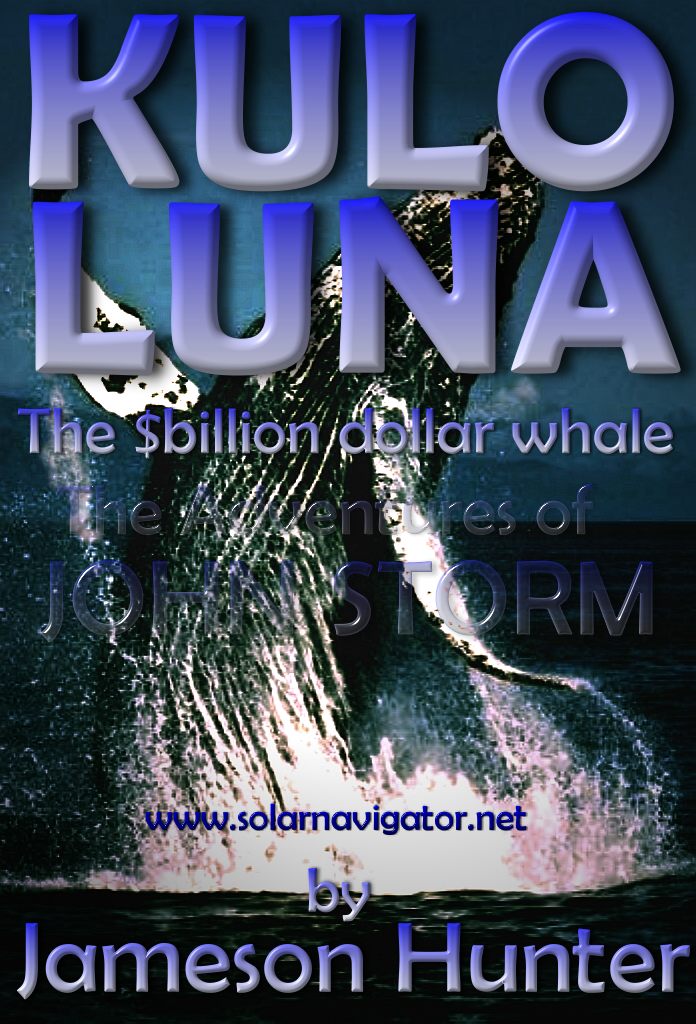
New
energy drinks for performers
..
Thirst for Life

Solar
Cola™ - 330ml
Earth can design© - the World in Your Hands
|






